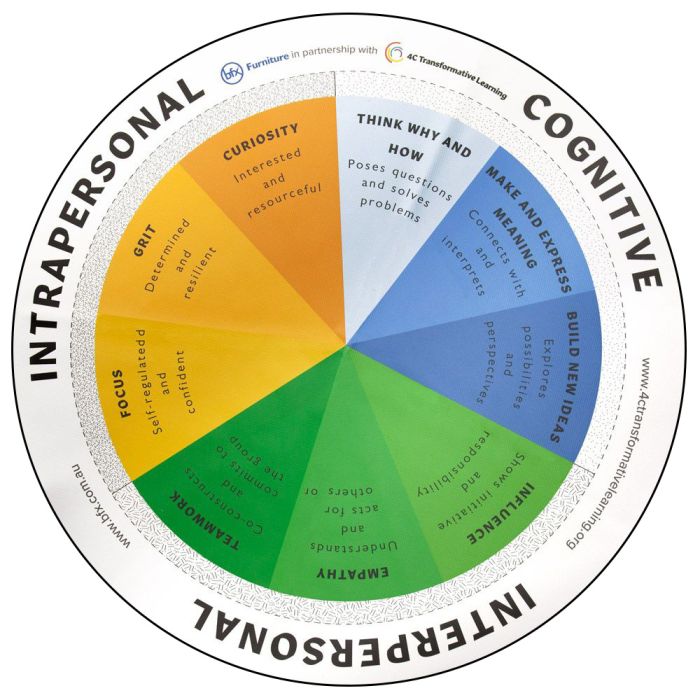Learning Disposition Wheel
We Make It Easy!
With over 60 Sales & Project Consultants Australia-wide, help is always nearby.
- Free expert product advice
- Free space planning and colour coordination
- Free on-site consultations
We are dedicated to exceptional customer experience from initial consultation through to installation and ongoing aftercare and support.
Features
- Designed to support students, teachers and the broader school community (parents etc)
- Gives an understand of qualities that help schools become places where deep and connected learning flourishes
- Measures 900mm diameter
- Printed on washable, durable canvass
- Eye catching classroom resource
- Flexible resource - use on a top table, floor or any flat indoor or outdoor learning space.
- Easy to store - simply to roll up and stow away when not in use
Description
The Learning Disposition Wheel was designed to support students, teachers and the broader school community (parents etc) to understand the qualities that help schools become places where deep and connected learning flourishes.
The Wheel measures 900mm diameter and is printed on washable, durable canvass making it an eye catching classroom resource which has flexibility to use on a top table, floor space or any flat indoor or outdoor learning environment. It is also simply to roll up and stow away when not in use.
The Learning Disposition Wheel was first published in Transforming Schools (Jefferson and Anderson, 2017) and is now used across early childhood learning, primary, secondary and tertiary education to deepen and connect learning.
The design of the wheel emerged from a realisation that for learning to go beyond surface understandings we need to not only understand the ‘what’ of learning (geography, numeracy, history, drama etc) we need how to learn deeply and connect up our learning.
The wheel is made up of three broad interdepentent domains:
Interpersonal: the capacity to express, interpret and respond to messages from others;
Intrapersonal: the capacity of self-regulating emotions and behaviours to achieve goals;
Cognitive: the capacity to think and reason.
To learn deeply we need to develop dispositions that cover all of those domains. As you may notice in the wheel, the domains do not sit by themselves, they are interdependent.
Learning is not just cognitive, it relies on the development of intrapersonal and interpersonal dispositions such as teamwork and grit to learn effectively. In other words, you can’t have two-thirds of a wheel. A wheel relies upon each segment to function.
So in reality this is not just a wheel for learning geography or science it also helps us learn about relationships (teamwork), create a persuasive argument (influence) or help others (empathy). In that sense it is a wellbeing wheel as well.
The advantage of having an agreed set of learning dispositions across an early childhood centre, school or tertiary institution allows a coherent and connected approach to learning for students, teachers and the broader school community.
This means that dispositions that are introduced in early childhood can be developed into year 2 and then onto year 6 and so on. In secondary schools it means that learning in maths can connect to learning in art and languages education creating connections across the curriculum.
For further information, including frequently asked questions, research behind the wheel, and an overview on what it's used for and how teachers utilise the Wheel, see the Learning Disposition Wheel User Guide page on this website.
Source - Jefferson, M., & Aderson, M. (2021). Transforming Education: Reimagining Learning, Pedagogy and Curriculum Bloomsbury Publishing will be available April 2021.
SIZE (Millimetres)
900Dia x 2D
COLOUR
Full colour printed on white canvass

Loading Reviews...






